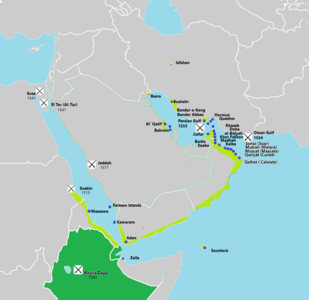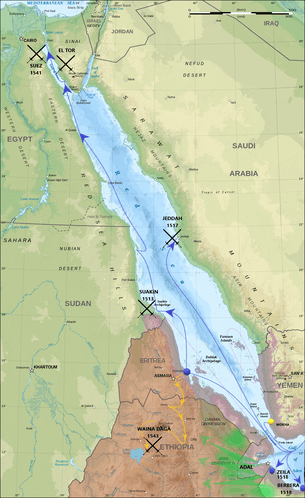Ottoman–Portuguese confrontations
The Ottoman–Portuguese or Turco-Portuguese confrontations[2][3][4] refers to a series of different military encounters between the Portuguese Empire and the Ottoman Empire, or between other European powers and the Ottoman Empire in which relevant Portuguese military forces participated. Some of these conflicts were brief, while others lasted for many years. Most of these conflicts were in the Indian Ocean, in the process of the expansion of the Portuguese Empire. These conflicts also involved regional powers, after 1538 the Adal Sultanate, with the aid of the Somali Ajuran Empire and the Ottoman Empire, fought against the Ethiopian Empire. The Ethiopians were supported by the Portuguese, under the command of Cristóvão da Gama, the son of the famous explorer Vasco da Gama. This war is known as the Ethiopian–Adal war.


Conflicts
The different conflicts were the following:
- Portuguese expedition to Otranto (1481)
- Siege of Jeddah (1517)
- Siege of Diu (1531)
- Siege of Diu (1538)
- Ottoman–Portuguese conflicts (1538–1559)
- Capture of Aden (1548)
- Capture of Muscat (1552)
- Battle of the Gulf of Oman (1554)
- Ottoman expedition to Aceh
- Ottoman–Portuguese conflicts (1586–1589)
Notes
- Whiteway, R. S. (June 1995). Rise of Portuguese Power in India Por R. S. Whiteway. ISBN 9788120605008.
- Mohammed Hasen al- Aidarous, The Ottoman-portuguese conflict in the Arabian Gulf during the second half of the 16th century.
- Suraiya Faroqhi, Approaching Ottoman history: an introduction to the sources, Cambridge University Press, 1999, p. 68.
- Salih Özbaran, The Ottoman response to European expansion: studies on Ottoman-Portuguese relations in the Indian Ocean and Ottoman administration in the Arab lands during the sixteenth century, Isis Press, 1994, viii